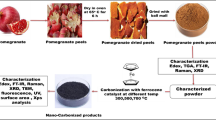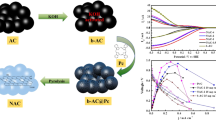Abstract
A single-chamber microbial fuel cell (SCMFC) was constructed using activated carbon derived from ground nutshells (GAC) as a metal-free cathode catalyst. The prepared cathode catalyst was characterized by X-ray photoelectron spectroscopy (XPS), Brunauer-Emmett-Teller (BET), and Field emission scanning electron microscopy (FE-SEM), which demonstrates the chemical composition and the surface morphology of the synthesized material. The electrochemical characteristics of the cathode were investigated by electrochemical impedance spectroscopy (EIS) and cyclic voltammetry (CV) analysis, which confirmed the high charge transfer capacity and catalytic activity property of GAC catalyst material. The MFC with GAC catalyst produces a maximum output voltage of 0.619 V and which is 1.61 times greater than that of bare carbon cloth (CC). For Pt/C and GAC-modified CC, high power density values of 0.763 W m−2 and 0.521 W m−2 were obtained at current densities 1.65 A m−2 and 1.0 A m−2, respectively at 100 Ω. These results demonstrate that the GAC/CC is a promising cost-effective cathode catalyst for SCMFC.








Similar content being viewed by others
References
You S, Zhao Q, Zhang J, Liu H, Jiang J, Zhao S (2008) Increased sustainable electricity generation in up-flow air-cathode microbial fuel cells. Biosens Bioelectron 23:1157–1160. https://doi.org/10.1016/j.bios.2007.10.010
Zheng X, Streimikiene D, Balezentis T, Mardani A, Cavallaro F, Liao H (2019) A review of greenhouse gas emission profiles, dynamics, and climate change mitigation efforts across the key climate change players. J Clean Prod 234:1113–1133. https://doi.org/10.1016/j.jclepro.2019.06.140
Shen M, Huang W, Chen M, Song B, Zeng G, Zhang Y (2020) (Micro) plastic crisis: un-ignorable contribution to global greenhouse gas emissions and climate change. J Clean Prod 254:120138. https://doi.org/10.1016/j.jclepro.2020.120138
Mohamed HO, Obaid M, Yasin AS, Kim JH, Barakat AM (2016) Performance of crystalline and amorphous carbonaceous anodes for MFCs. RSC Adv 6:111657–111665. https://doi.org/10.1039/C6RA22867D
Xue W, Zhou Q, Li F, Ondon BS (2019) Zeolitic imidazolate framework-8 (ZIF-8) as robust catalyst for oxygen reduction reaction in microbial fuel cells. J Power Sources 423:9–17. https://doi.org/10.1016/j.jpowsour.2019.03.017
Slate AJ, Whitehead KA, Brownson DAC, Banks CE (2019) Microbial fuel cells: an overview of current technology. Renew Sust Energ Rev 101:60–81. https://doi.org/10.1016/j.rser.2018.09.044
Saba B, Christy AD, Yu Z, Co AC (2017) Sustainable power generation from bacterio-algal microbial fuel cells (MFCs): an overview. Renew Sust Energ Rev 73:75–84. https://doi.org/10.1016/j.rser.2017.01.115
Palanisamy G, Jung H-Y, Sadhasivam T, Kurkuri MD, Kim SC, Roh SH (2019) A comprehensive review on microbial fuel cell technologies: processes, utilization, and advanced developments in electrodes and membranes. J Clean Prod 19:30571–30572. https://doi.org/10.1016/j.jclepro.2019.02.172
Lee DJ, Chang JS, Lai JY (2015) Microalgae-microbial fuel cell: a mini review. Bioresour Technol 198:891–895. https://doi.org/10.1016/j.biortech.2015.09.061
Pant D, Van Bogaert G, Diels L, Vanbroekhoven K (2010) A review of the substrates used in microbial fuel cells (MFCs) for sustainable energy production. Bioresour Technol 101:1533–1543. https://doi.org/10.1016/j.biortech.2009.10.017
Gupta S, Srivastava P, Patil SA, Kumar Yadav A (2020) A comprehensive review on emerging constructed wetland coupled microbial fuel cell technology: potential applications and challenges. Bioresour Technol 320:124376. https://doi.org/10.1016/j.biortech.2020.124376
Guo K, Prévoteau A, Patil SA, Rabaey K (2015) Engineering electrodes for microbial electrocatalysis. Curr Opin Biotechnol 33:149–156. https://doi.org/10.1016/j.copbio.2015.02.014
Wei J, Liang P, Huang X (2011) Recent progress in electrodes for microbial fuel cells. Bioresour Technol 102:9335–9344. https://doi.org/10.1016/j.biortech.2011.07.019
Zhou M, Chi M, Luo J, Hea H, Jin T (2011) An overview of electrode materials in microbial fuel cells. J Power Sources 196:4427–4435. https://doi.org/10.1016/j.jpowsour.2011.01.012
Santoro C, Arbizzani C, Erable B, Ieropoulos I (2017) Microbial fuel cells: from fundamentals to applications, A review. J Power Sources 356:225–244. https://doi.org/10.1016/j.jpowsour.2017.03.109
Wang CT, Sangeetha T, Ding DQ, Chong WT, Yan WN (2018) Implementation of surface modified carbon cloth electrodes with biochar particles in microbial fuel cells. Int J Green Energy 15:789–794. https://doi.org/10.1080/15435075.2018.1529576
Yan L, Yu J, Houston J, Flores N, Luo H (2017) Biomass derived porous nitrogen doped carbon for electrochemical devices. Green Energy Environ 2:84–99. https://doi.org/10.1016/j.gee.2017.03.002
Wang J, Li Y, Yan L, Qu Y (2018) Nitrogen-phosphorus co-doped porous carbon based on peanut shell for surpercapactior. Int J Electrochem Sci 13:6259–6271. https://doi.org/10.20964/2018.07.47
Liu L, Yang L, Wang P, Wang CY, Cheng J, Zhang G (2017) Porous Nitrogen-doped carbon derived from peanut shell as anode material for lithium ion battery. Int J Electrochem Sci 12:9844–9854. https://doi.org/10.20964/2017.10.88
Li D, Deng L, Yuan H, Dong G, Chen J, Zhang X, Chen Y, Yuan Y (2018) N, P-doped mesoporous carbon from onion as trifunctional metal-free electrode modifier for enhanced power performance and capacitive manner of microbial fuel cells. Electrochim Acta 262:297–305. https://doi.org/10.1016/j.electacta.2017.12.164
Zhong K, Li M, Yang Y, Zhang H, Zhang B, Tang J, Yana J, Su M, Yang Z (2019) Nitrogen-doped biochar derived from watermelon rind as oxygen reduction catalyst in air cathode microbial fuel cells. Appl Energy 242:516–525. https://doi.org/10.1016/j.apenergy.2019.03.050
Li M, Zhang H, Xiao T, Wang S, Zhang B, Chen D, Su M, Tang J (2018) Low-cost biochar derived from corncob as oxygen reduction catalyst in air cathode microbial fuel cells. Electrochim Acta 283:780–788. https://doi.org/10.1016/j.electacta.2018.07.010
Zhang P, Liu X, Li K, Lu Y (2015) Heteroatom-doped highly porous carbon derived from petroleum coke as efficient cathode catalyst for microbial fuel cells. Int J Hydrog Energy 40:13530–13537. https://doi.org/10.1016/j.ijhydene.2015.08.025
Zheng FY, Li R, Ge S, Xu WR, Zhang Y (2020) Nitrogen and phosphorus co-doped carbon networks derived from shrimp shells as an efficient oxygen reduction catalyst for microbial fuel cells. J Power Sources 446:227356. https://doi.org/10.1016/j.jpowsour.2019.227356
Yuan H, Deng L, Qi Y, Kobayashi N, Tang J (2014) Nonactivated and activated biochar derived from bananas as alternative cathode catalyst in microbial fuel cells. Sci World J 2014:8–8. https://doi.org/10.1155/2014/832850
Chakraborty I, Bhowmick GD, Ghosh D, Dubey BK, Pradhanc D, Ghangrekar MM (2020) Novel low-cost activated algal biochar as a cathode catalyst for improving performance of microbial fuel cell. Sustain Energy Technol Assess 42:100808. https://doi.org/10.1016/j.seta.2020.100808
Bose D, Sridharan S, Dhawan H, Vijay P, Gopinath M (2019) Biomass derived activated carbon cathode performance for sustainable power generation from Microbial Fuel Cells. Fuel 236:325–337. https://doi.org/10.1016/j.fuel.2018.09.002
Yang W, Li J, Ye D, Zhu X, Liao Q (2017) Bamboo charcoal as a cost-effective catalyst for an air-cathode of microbial fuel cells. Electrochim Acta 224:585–592. https://doi.org/10.1016/j.electacta.2016.12.046
Pepe Sciarria T, de Oliveira MAC, Mecheri B, Epifanio AD, Goldfarb JL, Adani F (2020) Metal-free activated biochar as an oxygen reduction reaction catalyst in single chamber microbial fuel cells. J Power Sources 462:462. https://doi.org/10.1016/j.jpowsour.2020.228183
Musekiwa P, Moyo LB, Mamvura TA, Danha G, Simate GS, Hlabangana N (2020) Optimization of pulp production from groundnut shells using chemical pulping at low temperatures. Heliyon 6:e04184. https://doi.org/10.1016/j.heliyon.2020.e04184
Alshabib M, Oluwadamilare MA, Tanimu A, Abdulazeez I, Alhooshani K, Ganiyu SA (2021) Experimental and DFT investigation of ceria-nanocomposite decorated AC derived from groundnut shell for efficient removal of methylene-blue from wastewater effluent. Appl Surf Sci 536:147749. https://doi.org/10.1016/j.apsusc.2020.147749
Karthick S, Haribabu K (2020) Bioelectricity generation in a microbial fuel cell using polypyrrole-molybdenum oxide composite as an effective cathode catalyst. Fuel 275:117994. https://doi.org/10.1016/j.fuel.2020.117994
Senthilkumar K, Anappara S, Krishnan H, Ramasamy P (2020) Simultaneous power generation and Congo red dye degradation in double chamber microbial fuel cell using spent carbon electrodes. Energy Sources Part A Recover Util Environ Eff 1–17. https://doi.org/10.1080/15567036.2020.1781978
Karthick S, Sumisha A, Haribabu K (2020) Performance of tungsten oxide/polypyrrole composite as cathode catalyst in single chamber microbial fuel cell. J Environ Chem Eng 8:104520. https://doi.org/10.1016/j.jece.2020.104520
Sumisha A, Haribabu K (2018) Modification of graphite felt using nano polypyrrole and polythiophene for microbial fuel cell applications-a comparative study. Int J Hydrog Energy 43:3308–3316. https://doi.org/10.1016/j.ijhydene.2017.12.175
Sumisha A, Ashar J, Asok A, Karthick S, Haribabu K (2019) Reduction of copper and generation of energy in double chamber microbial fuel cell using Shewanella putrefaciens. Sep Sci Technol 55:1–9. https://doi.org/10.1080/01496395.2019.1625919
Mane AT, Navale ST, Sen S, Aswal DK, Gupta SK, Patilet VB (2015) Nitrogen dioxide (NO2) sensing performance of p-polypyrrole/n-tungsten oxide hybrid nanocomposites at room temperature. Org Electron 16:195–204. https://doi.org/10.1016/j.orgel.2014.10.045
Logan B, Hamelers E, Rozendal B, Freguia S, Aelterman P, Verstraete W, Rabaey K (2006) Microbial fuel cells: methodology and technology. Environ Sci Technol 40:5181–5192. https://doi.org/10.1021/es0605016
Acknowledgements
The authors would like to thank the Chemical Department, NIT Calicut, for the continuous supports and assistance during the work. We also would like to thank Mr. Pratheek, Ms. Nova Elezabath E.A, Ms. Meenu. K.Mohan, and Dr. A. Sumisha for the help and support during the work.
Author information
Authors and Affiliations
Corresponding author
Additional information
Publisher’s Note
Springer Nature remains neutral with regard to jurisdictional claims in published maps and institutional affiliations.
Rights and permissions
About this article
Cite this article
S, K., S, V., K, H. et al. Activated carbon derived from ground nutshell as a metal-free oxygen reduction catalyst for air cathode in single chamber microbial fuel cell. Biomass Conv. Bioref. 12, 1729–1736 (2022). https://doi.org/10.1007/s13399-021-01335-x
Received:
Revised:
Accepted:
Published:
Issue Date:
DOI: https://doi.org/10.1007/s13399-021-01335-x




